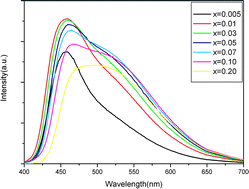An emission-tunable, Eu2+-activated, Ba2Ca(PO4)2:Eu2+ phosphor was synthesized by a conventional solid-state reaction. X-ray powder diffraction (XRD) and FT-IR spectroscopic analysis confirmed the phase formation. Electron paramagnetic resonance (EPR) analysis indicated there are three different crystallographic Ba2+ sites, namely, Ba(1), Ba(2) and Ba(3), occupied by the Eu2+ ions. The excitation and emission spectra, concentration dependence of the emission intensity and decay curves of the phosphor were investigated. The results showed that with increasing Eu2+ concentration, the emission peak wavelength redshifted from 457 to 500 nm, and the color hue can be tuned from a greenish blue to a yellowish green. A white LED was fabricated using a near ultraviolet (n-UV) 410 nm chip pumped with a blend of phosphors consisting of greenish blue-emitting Ba1.97Ca(PO4)2:0.03Eu2+ and red-emitting Ca3.97(PO4)2O:0.07Eu2+. When the applied current was 350 mA, the white LED had Commission International de l'Eclairage color coordinates of (0.3249, 0.3421) at a white light (correlated color temperature = 6020 K) and an excellent color rendering index of 93.

You have access to this article
 Please wait while we load your content...
Something went wrong. Try again?
Please wait while we load your content...
Something went wrong. Try again?


 Please wait while we load your content...
Please wait while we load your content...